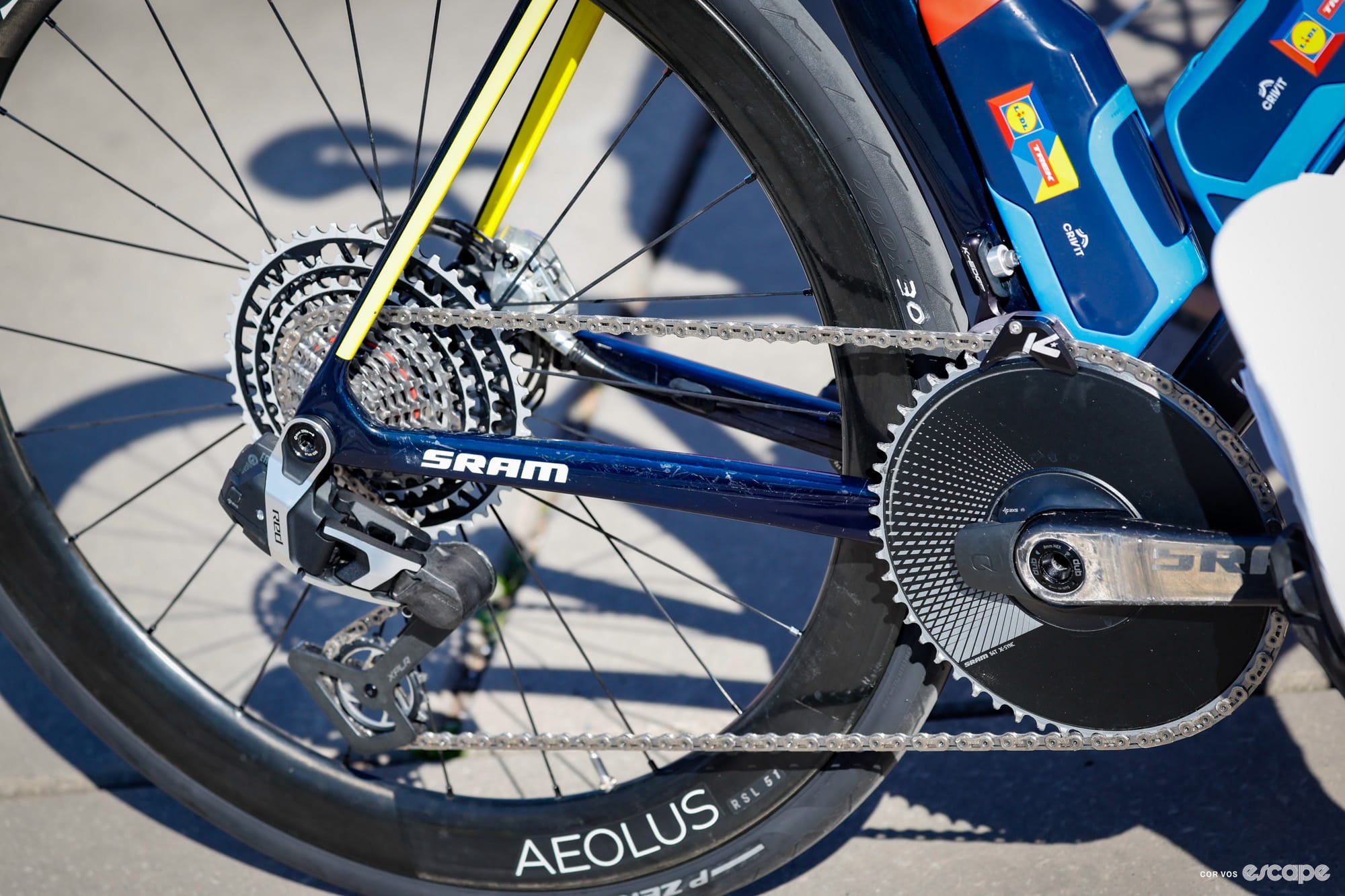Bike brands can take numerous approaches when designing a new bike, most of which we can boil down to some combination of lighter, stiffer, and faster, plus some new aesthetics. Today, though, Canyon has unveiled its new Aeroad, which looks remarkably like the outgoing third-generation Aeroad, and while Canyon does claim it has cemented the Aeroad in its position as the fastest bike in the WorldTour peloton, digging into the numbers – both weight and aero – reveals a wash with the outgoing bike. Instead, Canyon has focused on making the winning bike from the past two editions of Paris-Roubaix more … cobble-proof.
If being better over the cobbles seems like an odd area to optimise what is already the most successful bike over the cobbles in recent years, what Canyon is actually saying is that it's made the Aeroad more robust, durable, and, in a refreshing turn up for the books, more user- and mechanic-friendly.

With handlebar recalls, stop-ride notices, and seatpost issues, it's fair to say the previous-generation Aeroad had problems. Now, as it launches the fourth iteration of the Aeroad, Canyon seemingly wasn't keen on having any issues with the new bike, and for once, the pendulum-swing response seems to be in a very positive direction.
Sure, there are narrower tube profiles, deeper forks, and claims of stiffer, faster, lighter this and that, but Canyon has focused on refining, improving, and simplifying what it felt was good about Aeroad MK III to produce a bike that's more robust and easier to live with rather than a complete overhaul. As hinted at above, there's as much talk in the Canyon press materials of what the pro mechanics wanted as there is of what the pro riders wanted. Unsurprisingly, the updates those mechanics demanded are the kind of tweaks that might save new Aeroad owners time and money in after-sales servicing: things like more-durable headsets and more-robust frames that should better withstand minor impacts and crashes.
We have a new Aeroad in for a longer-term review in the coming months. That review wasn't possible in time for today's embargo due to that big race around France ... at which the new bike has already won three stages under Jasper Phillipsen. In the meantime, here's everything you need to know.
Keeping PACE
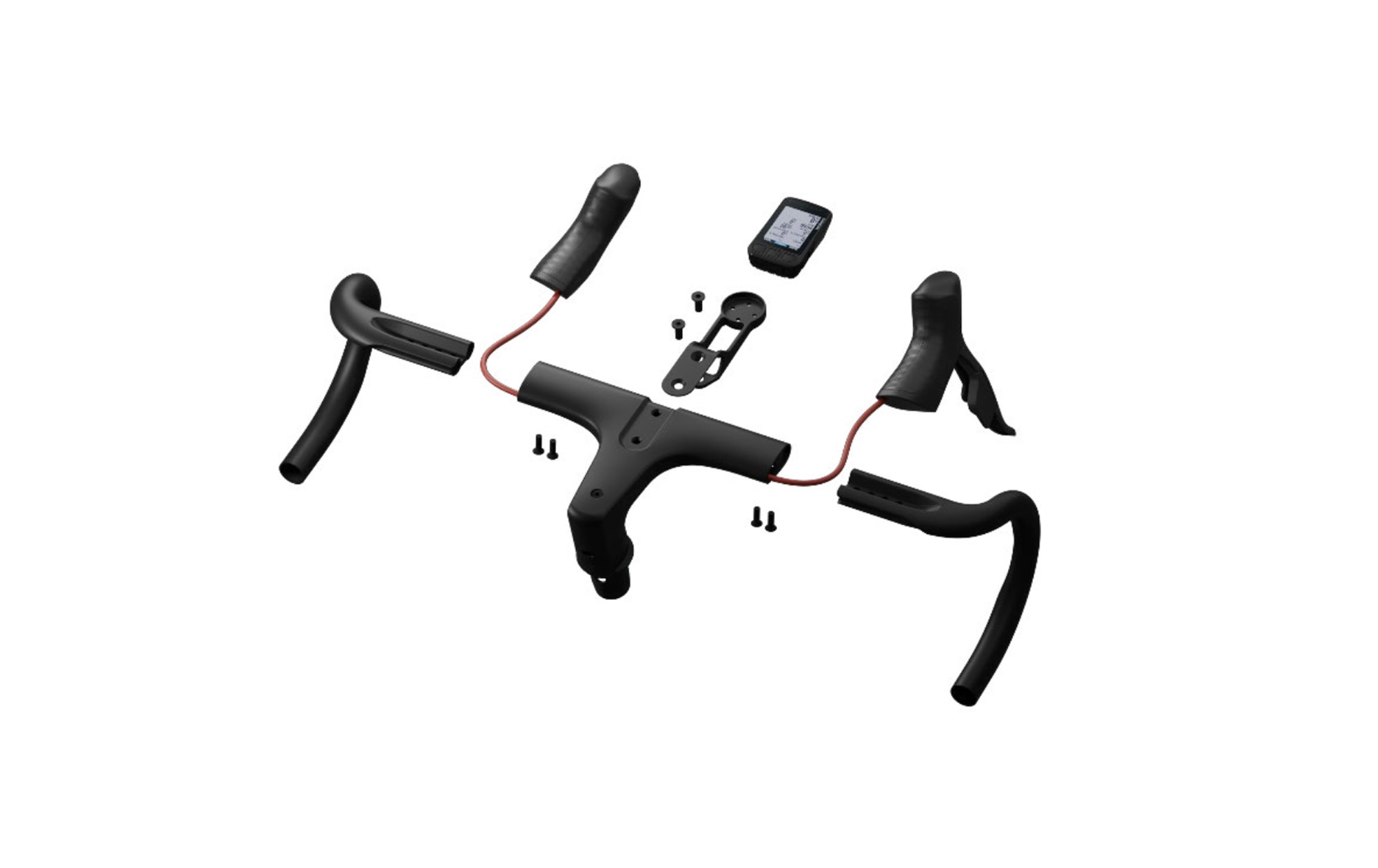
We'll get to the new frame shortly, but perhaps the most significant update to the new bike is Canyon's new Performance Adaptive Cockpit Ecosystem (PACE) ... or handlebars to you and I. The integrated handlebar and stem features modular and width-adjustable drops as was the case with the third-generation CP0018 cockpit on the previous Aeroad and up to 20 mm (5 mm more than the CP0018) of "no-cut" (fork steerer) stem height adjustment. Furthermore, the new bars also introduce several other updates to the new Aeroad, including a new, aftermarket aero drop shape, increased adjustability, and Canyon's new Gear Groove accessory mounting interface first seen on the new Grail.
The most interesting of these is the new aero drop shape option and the ability to quickly and easily swap the bar drop shape without cutting hoses or re-bleeding braking systems. This is made possible by external hose routing under the modular drop add-ons. While the new Aeroad features the same 2°, 130 mm round drop Canyon calls the "Classic Drop" as the CP0018 – offering up to 50 mm of width adjustment from 37 to 42 cm wide in its stock configuration – Canyon has added the new, narrower , 10 mm-longer reach, and 19° flared drop add-on its calling the "Aero Drops."
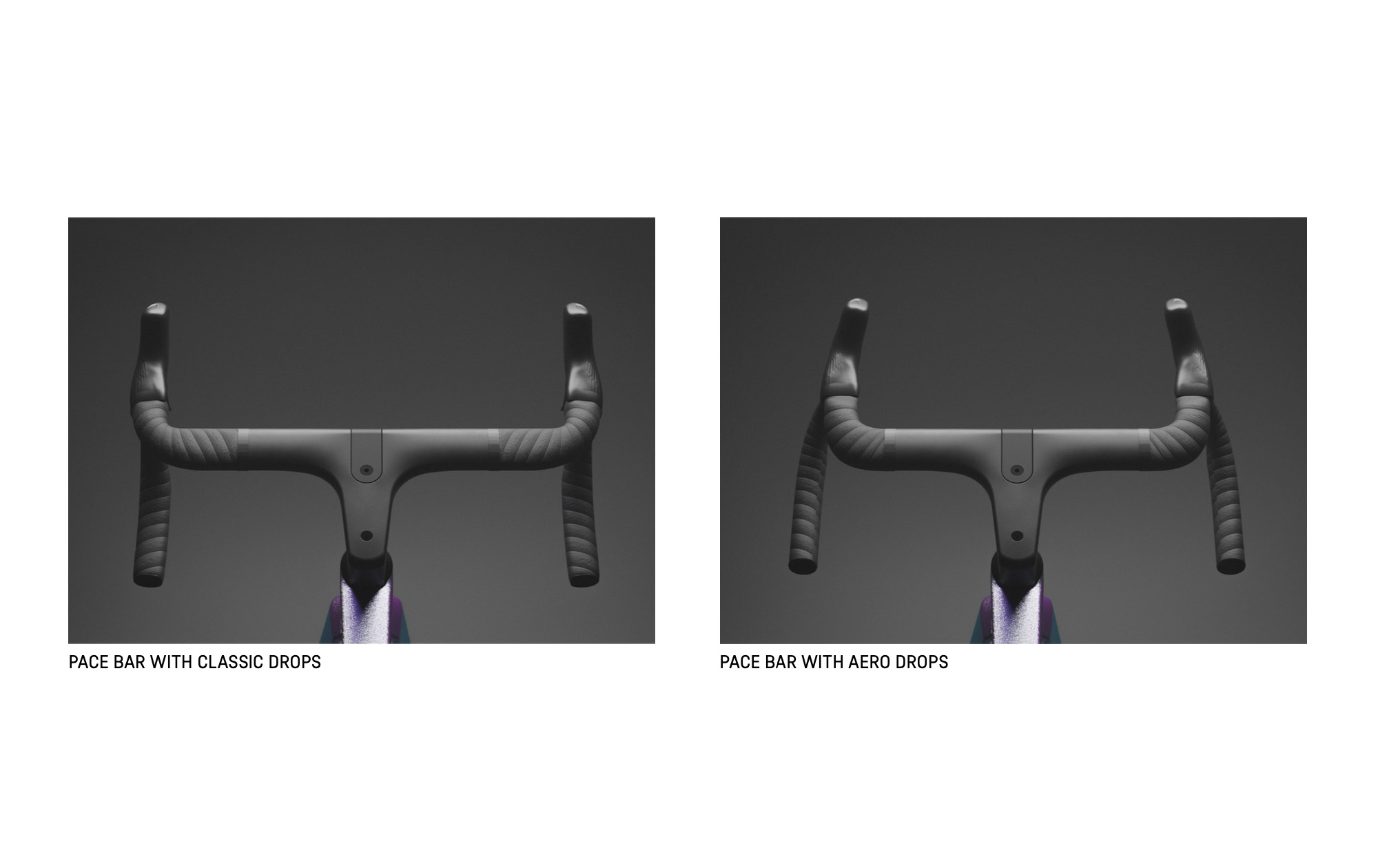
The Aero Drops, an aftermarket upgrade priced at €230, are not necessarily more aero in themselves but are designed to help riders adopt more aero positions and potentially offer a workaround for the UCI 10° maximum lever inclination rule. While the Aero Drops offer the same total 50 mm width adjustment, they are both 20 mm narrower – meaning riders can choose 35, 37.5, or 40 cm wide hoods – and offer 10 mm longer reach at the hoods than the Classic Drop option. The Aero Drops are also 25 mm shallower to help riders get into a lower position, and the more aggressive 19° flare should still provide a control position for descents and more wrist clearance for sprinting.
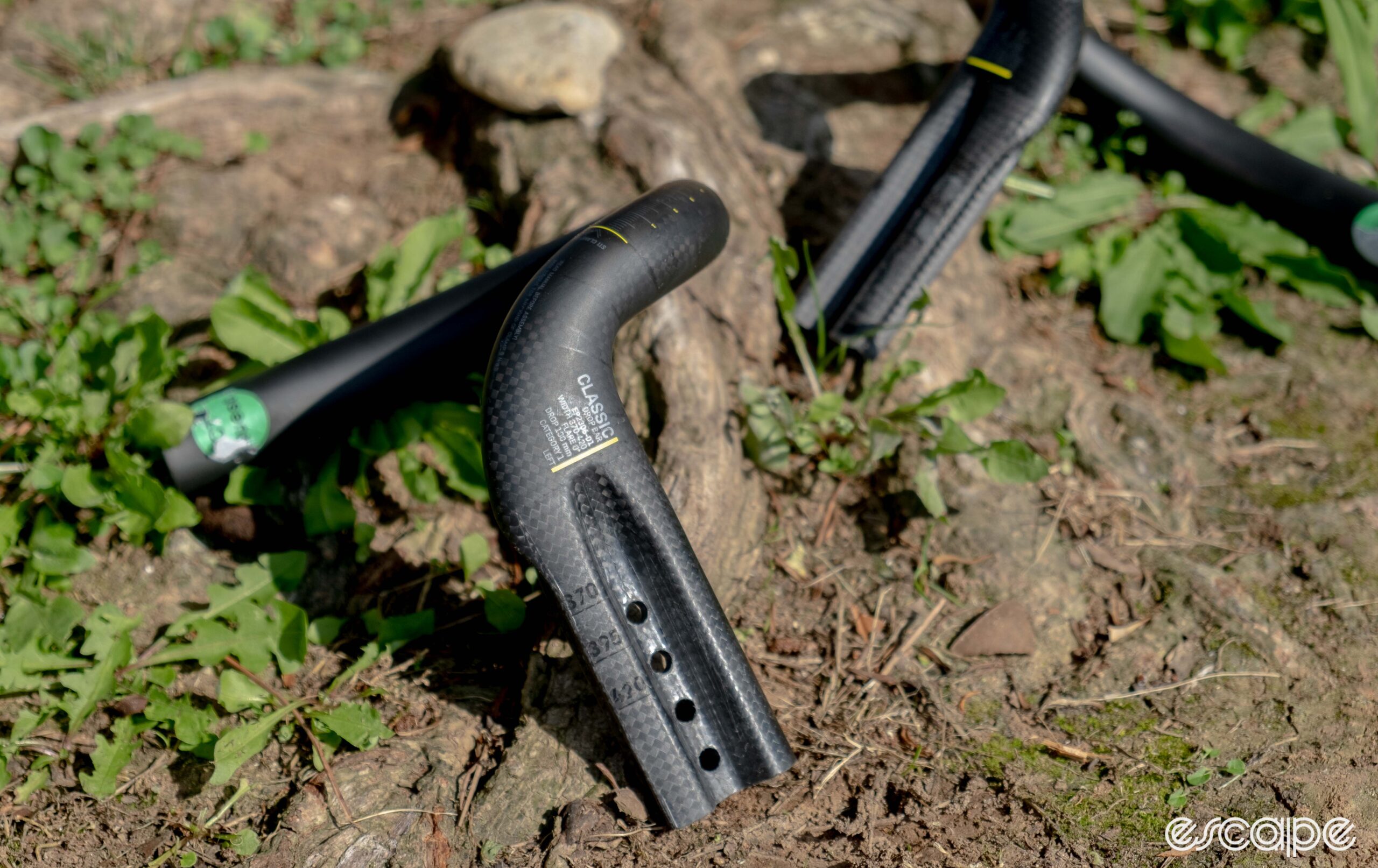
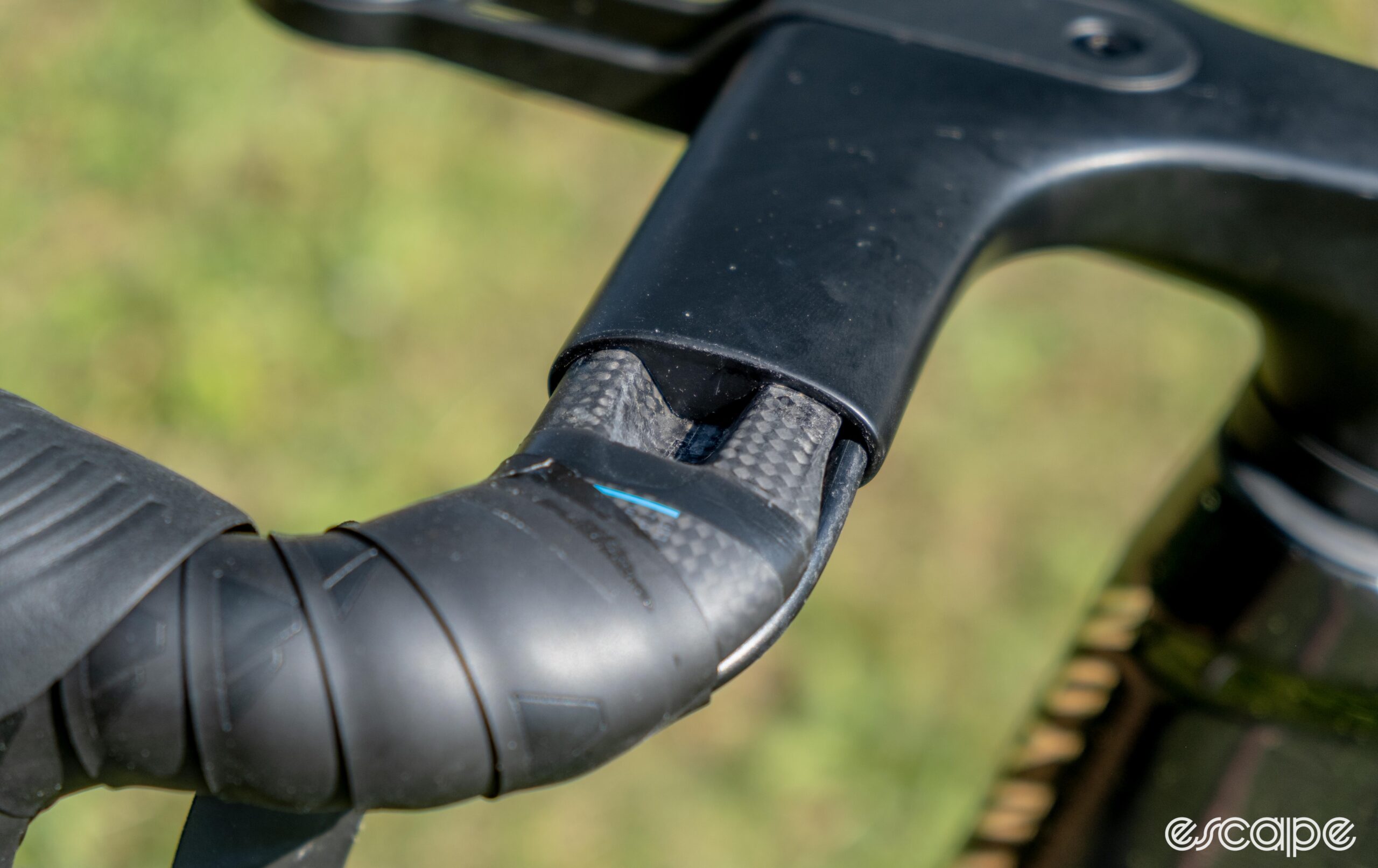
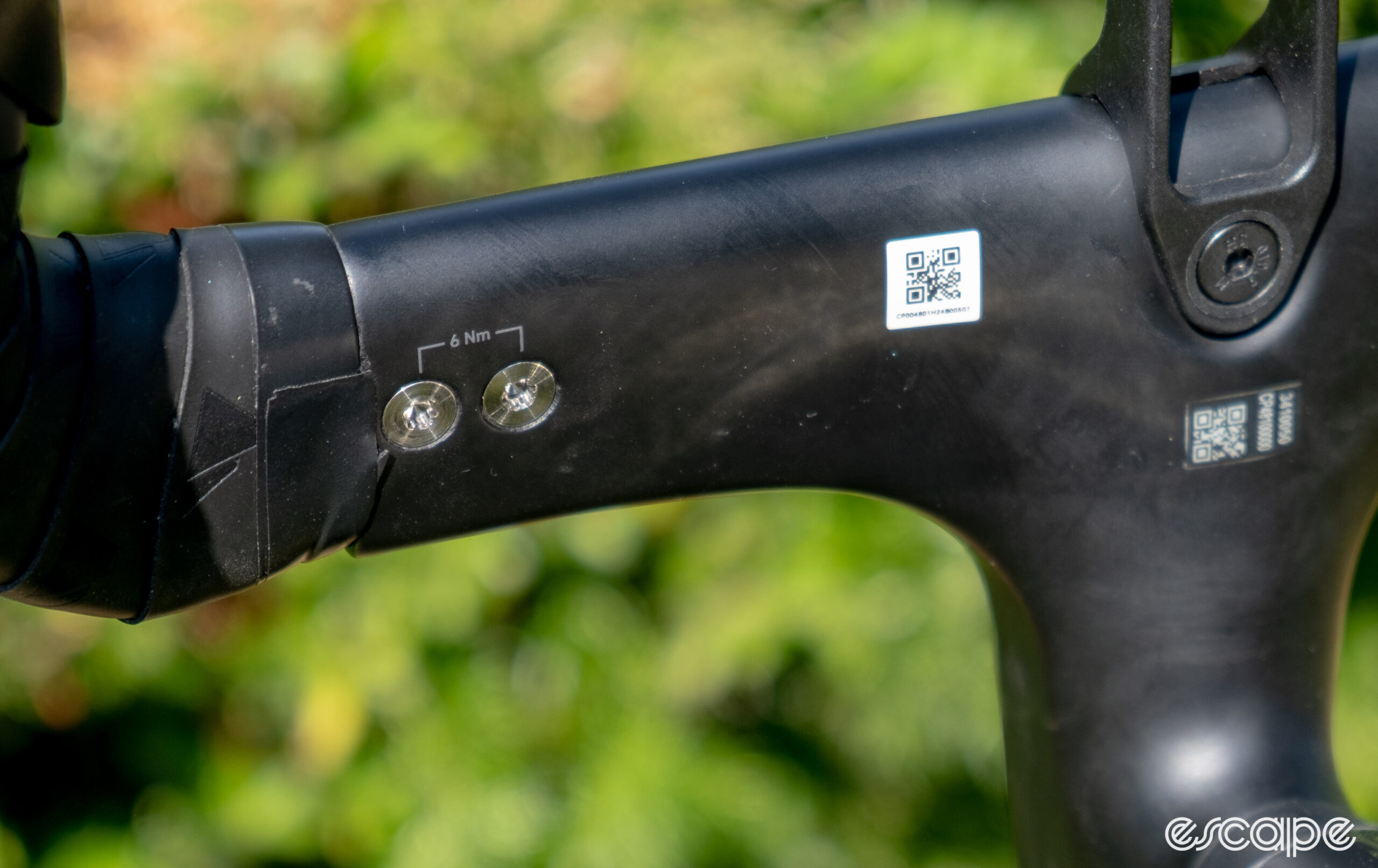
How much more aero are the Aero Drops? According to Canyon's own wind tunnel and velodrome aero testing, the Aero Drops save (or perhaps more accurately, aid the rider in adopting a position which saves) 14 watts compared to the Classic Drops as tested across "multiple riders maintaining an aggressive lead-out position on the hoods". While Canyon is happy to admit most of these gains likely come from the improved rider position, the bars could genuinely help riders maintain that position, making this pretty extreme wattage-saving claim credible.
Canyon also mentioned that the interchangeable drop shapes open up options for optimising the setup for a given event, but truth be told, I envisage riders selecting one drop shape and sticking with it. Still, though, it's nice to have options, even if it would have been nicer to see the aero drops either included (which admittedly would then have to be factored into the price for everyone) or at least offered as a spec option.
Speaking of spec options, for all the customisation the bars offer, Canyon was a little sheepish in response to questions about whether customers could specify which stem length they require when ordering a new Aeroad. Officially, there isn't currently and won't be an option to specify stem length, although the T-section is available aftermarket in a range of sizes for €200, but I wouldn't be surprised if that changes in future. We've made our feelings on this at Escape Collective clear in the past, so for now, I'll leave it at this: it really should be an option.

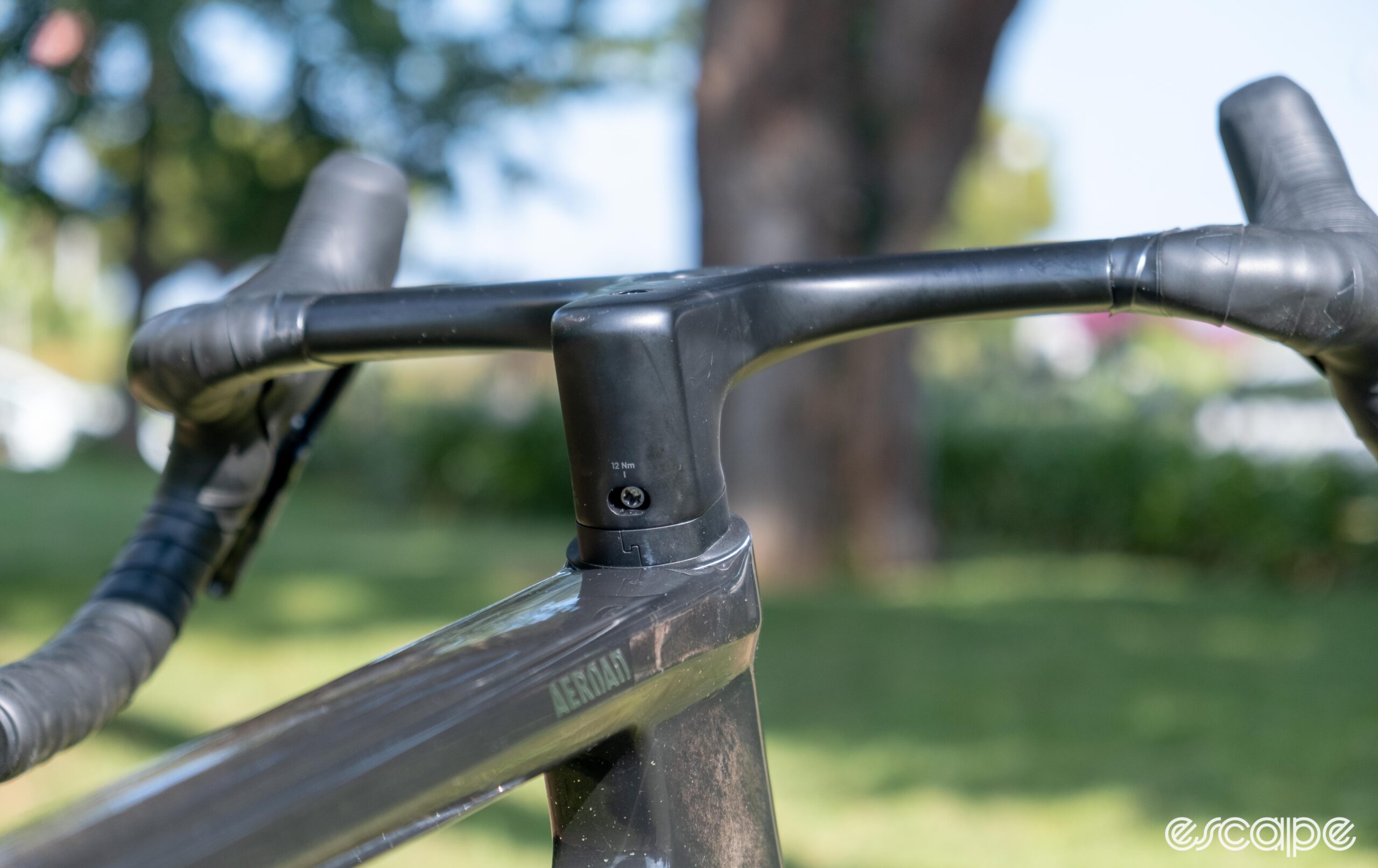
Canyon also claims the new stem is stiffer than the outgoing version and has also simplified setup and maintenance with headset preload now set using a standard T25 screw, eliminating the need for the proprietary tool required with the CP0018.
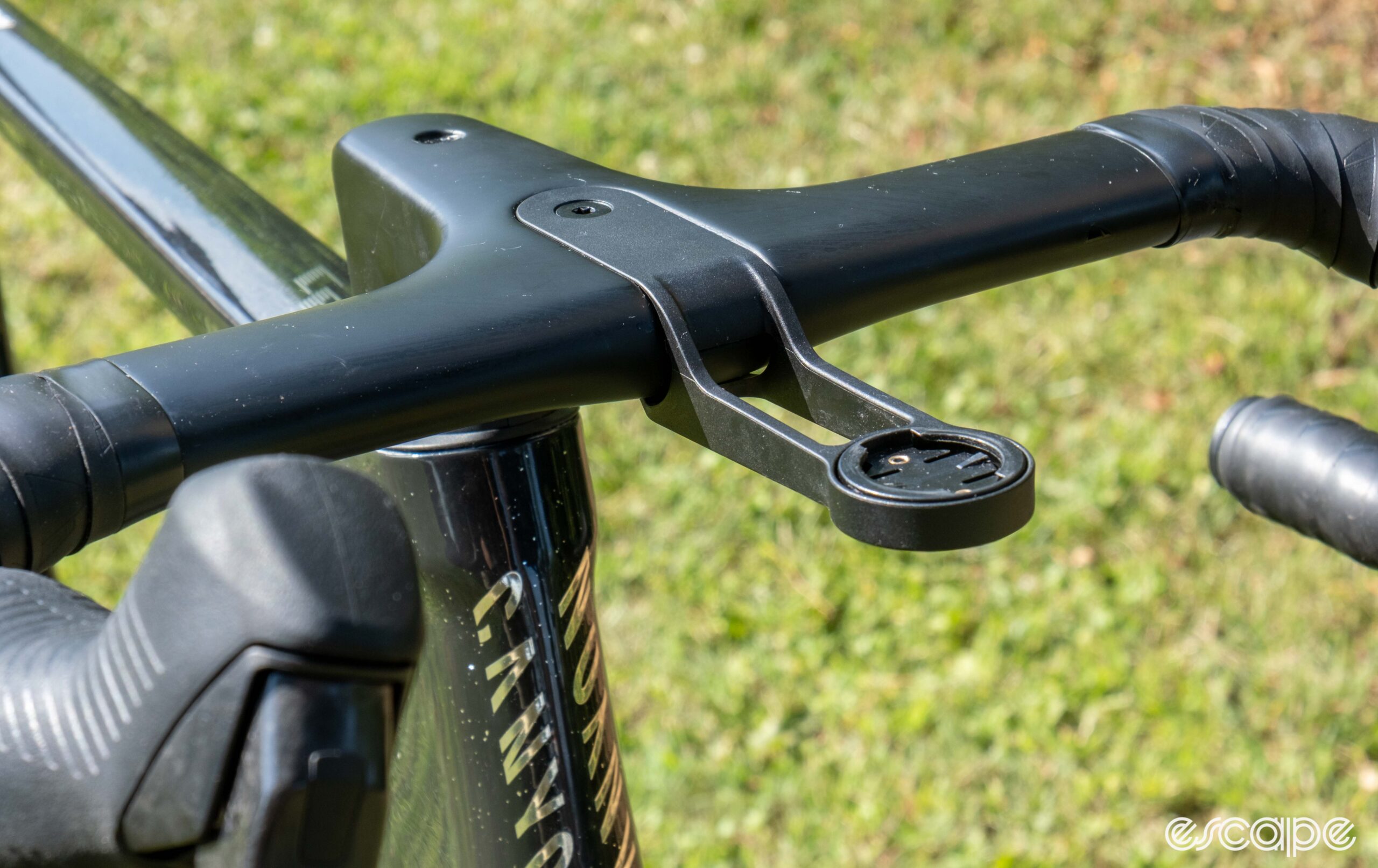
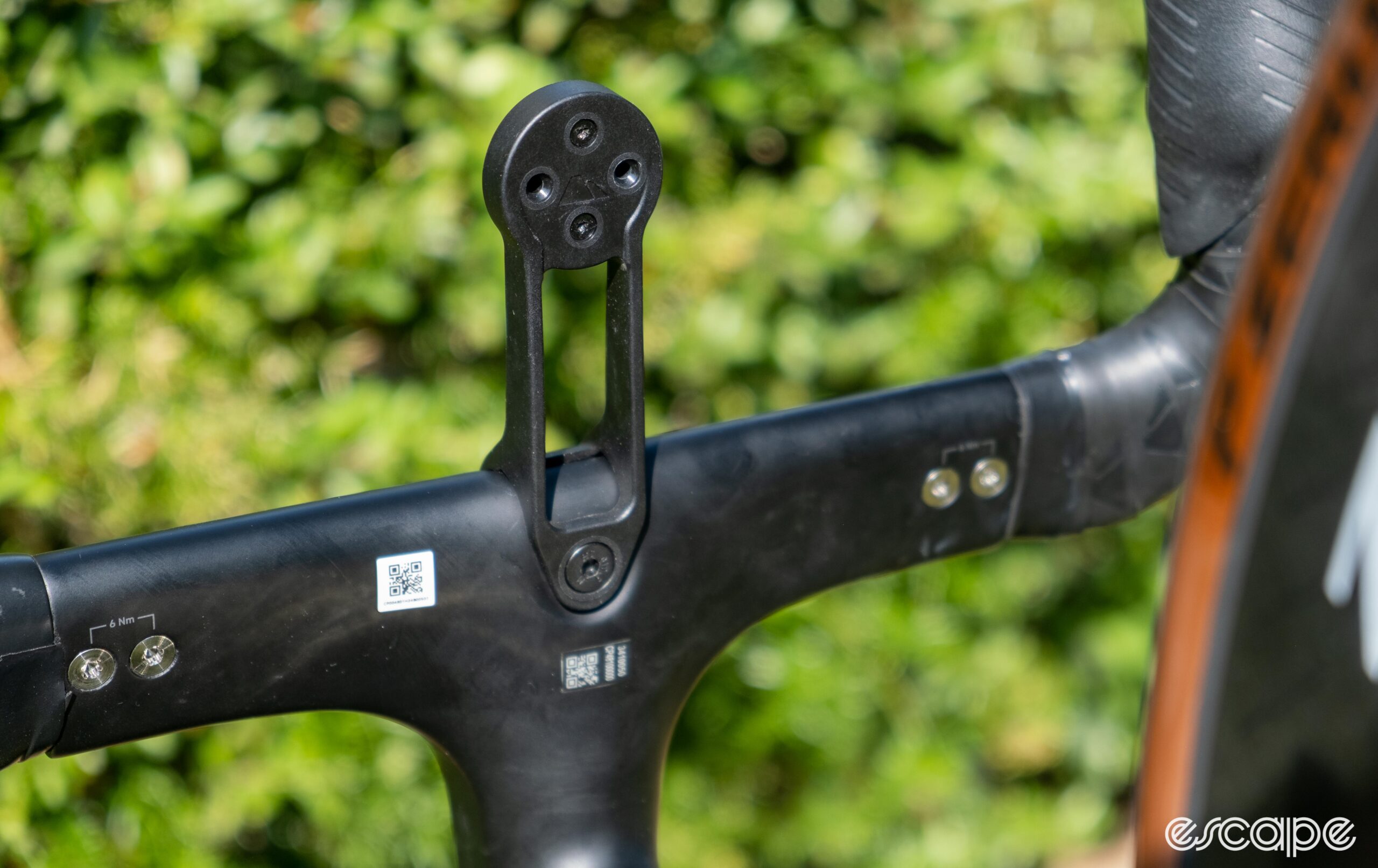
Finally, on the bars, Canyon has also incorporated its Gear Groove accessory mount interface first introduced on the new Grail. The interface is most commonly used for head unit mounts where the proprietary mount effectively sandwiches the groove section on the bar tops and is fastened top and bottom with T25 screws (if you are sensing a trend developing, hold that thought – we'll get back to the T25 screws in a bit) for a very secure setup. Canyon also offers clip-on aero bars a la the extensions found on the SpeedMax, with these mounting to the same Gear Groove interface (the head unit then mounts to the extensions). Canyon also promises that a host of other accessories are coming soon.
Cobble proof

As for the frame, while it may look the same as the outgoing model, there are actually considerable updates hiding in plain sight. Canyon claims the entire frameset has not only been refined with new tube profiles for improved aerodynamics, stiffness, reduced weight, and improved compliance, but many of the tubes have also been reinforced to be more robust in the field.
Chief amongst these is the new top tube, which Canyon says is broader and more robust thanks to a new "strengthened layup". The everyday benefit of this new top tube is a claimed increase in front-end stiffness and corresponding improvement in handling and responsiveness, while the hopefully-less-frequently-realised benefit is a top tube that should be less susceptible to handlebar impact damage that is often incurred during a crash. The new seat tube to seatstay interface is similarly reinforced, as are the new seatstays, all described by Canyon as slightly overbuilt with durability in mind rather than a gram or two of weight savings.

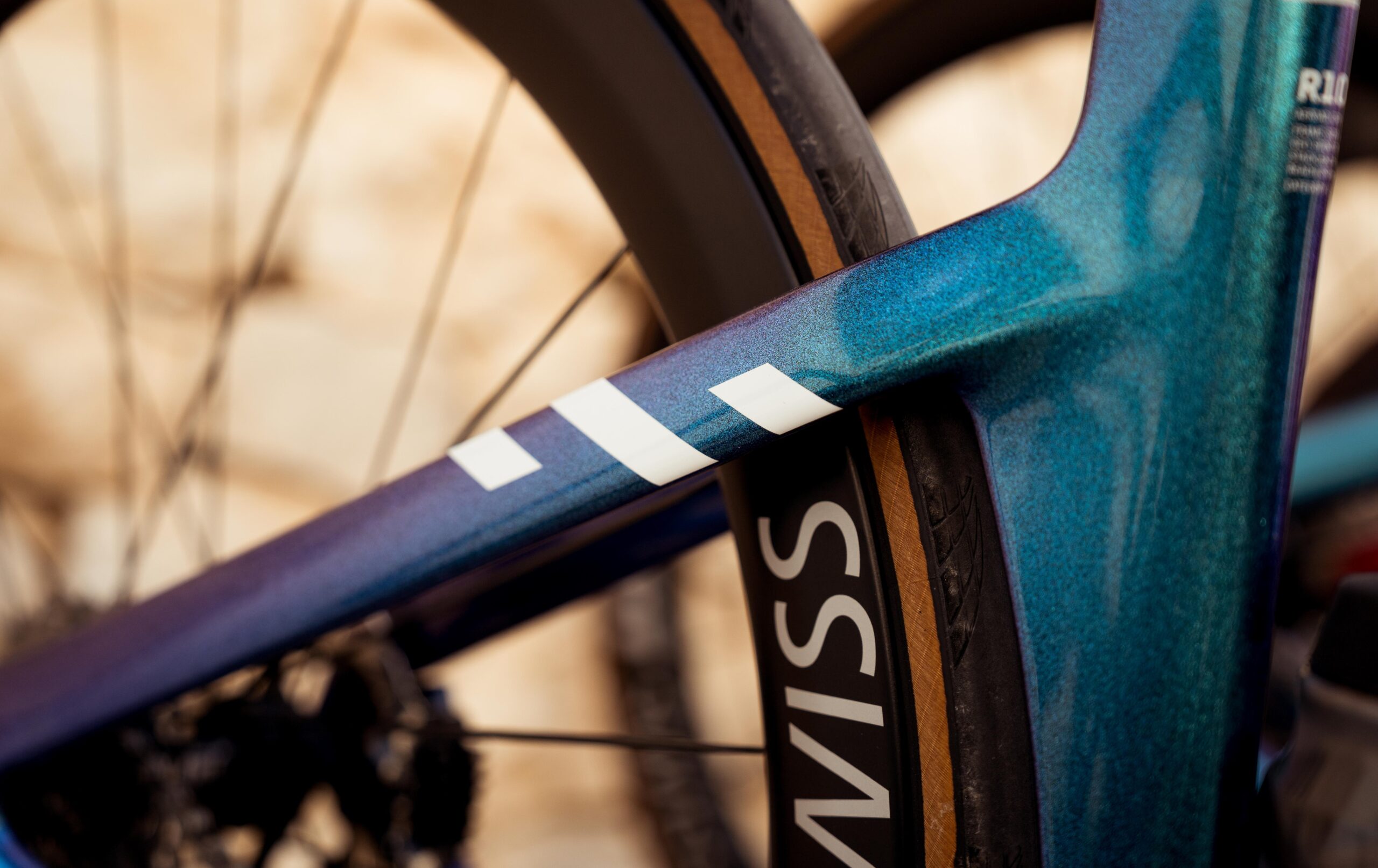
Rarely is it this late in an article about a new aero bike that we finally get around to what's actually more aero about the frame. But while the new Aeroad frame updates are relatively subtle, they nevertheless make plenty of sense. They include a narrower head tube and down tube, two things we know can make for a faster overall system. According to Canyon, the stiffness gains incorporated in that top tube make this narrowing of the head and down tubes possible without negatively impacting handling.
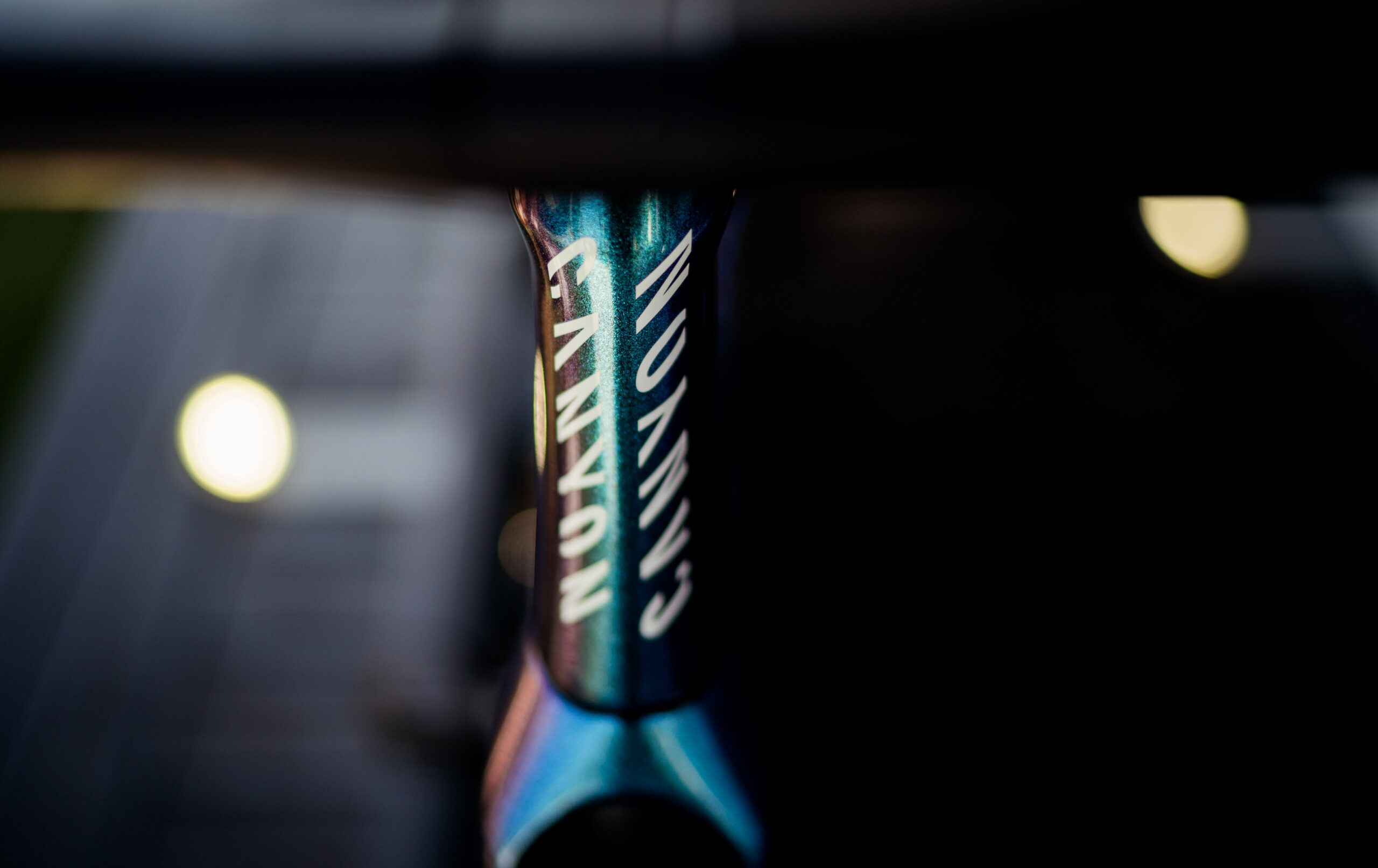
Sticking with tried-and-tested upgrades, Canyon has also introduced a new narrower and deeper fork profile for a slight aero gain. The forks now include tiny, replaceable strips of rubber along the bottom to protect paint and carbon when the front wheel is removed and the bike is resting on the fork legs. It's a simple thing, but also quite neat.
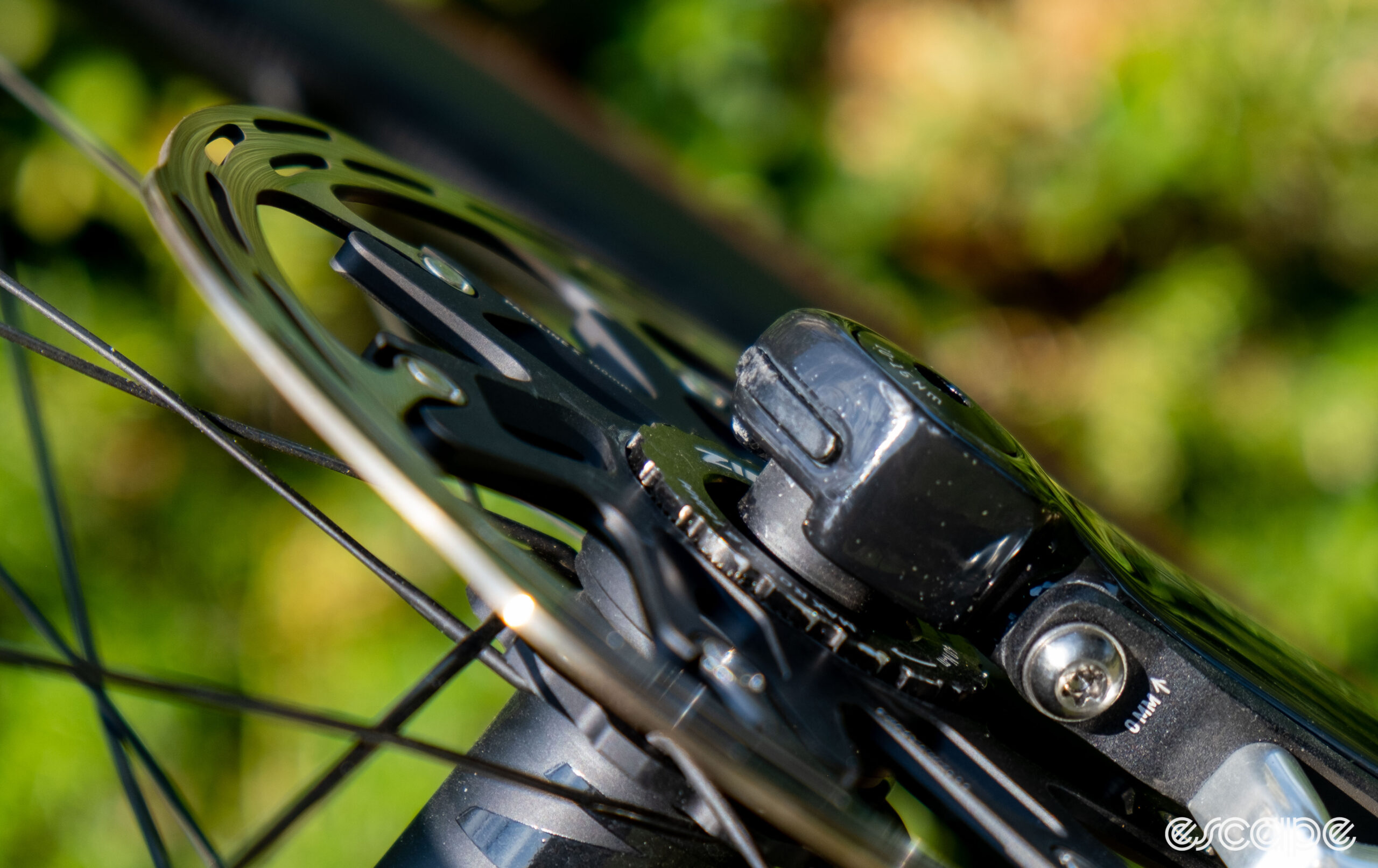
Of course, those forks also play a vital role in the cut-free height adjustment offered by the PACE bar cockpit and Canyon has retained the same quill-like design but has done away with the pesky proprietary tool that was previously required to make any adjustments. A single T25 head screw (there it is again) on the top cap and another on the stem itself now do all the headset tightening and stem retention work meaning just a single T25 (and a torque wrench) is all that is required to adjust the headset preload or stem height.
In fact, that same T25 bit is all you'll ever need as Canyon has spec'd the same size on every screw and bolt across the entire new Aeroad from derailleur hangers to handlebar drop retaining screws, to the seat post clamp, stem, and headset adjustment screw. Canyon has even included a T25 bit inside of the thru-axle tool meaning riders should always have the right tool at hand. For what it's worth, Canyon says it specifically chose T25 due to its reduced risk of rounding and more positive engagement versus a hex-head and commissioned its own slightly deeper and tougher heads (and so screws) just for the job.

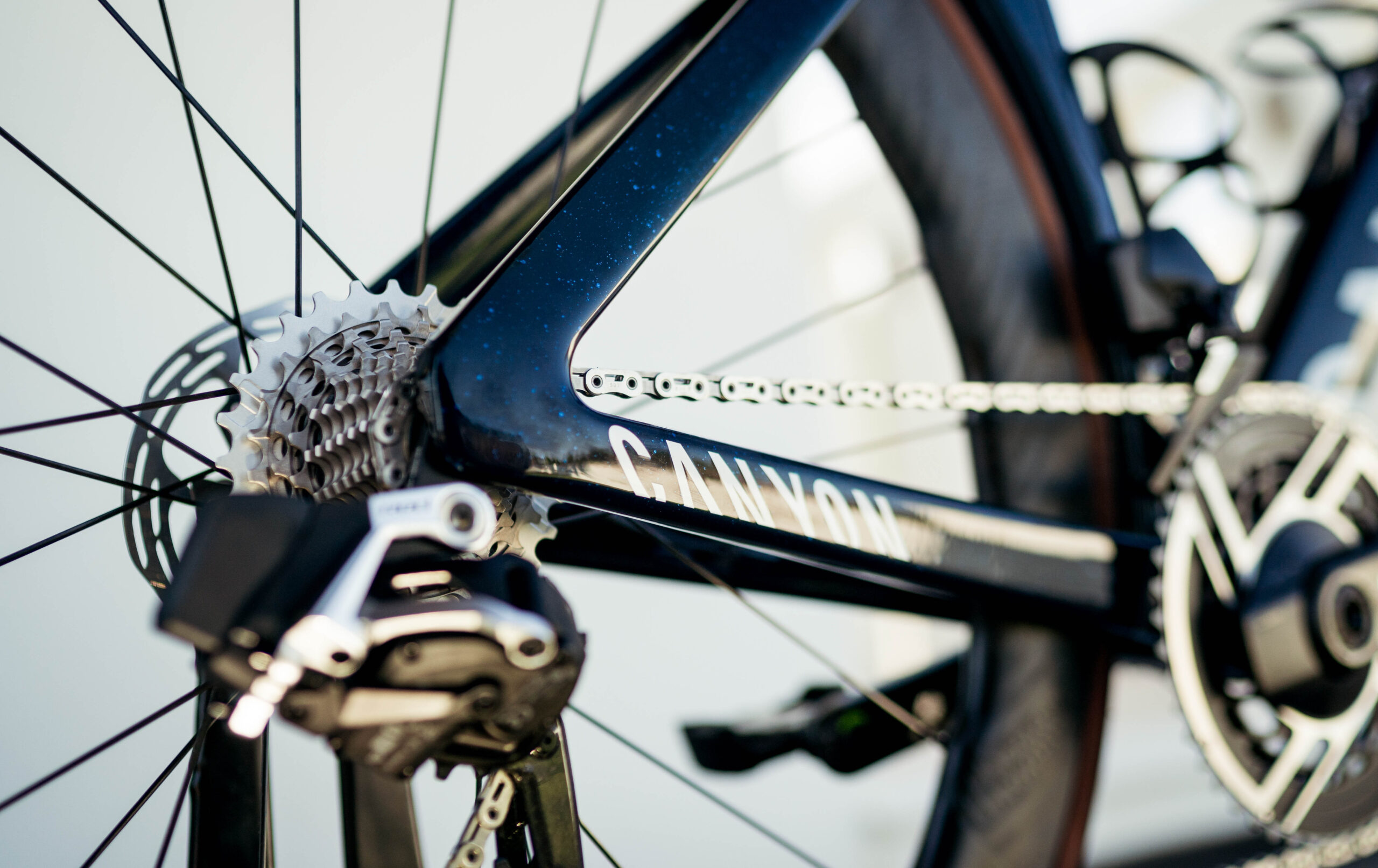
Sticking with thru-axle stuff, Canyon has adopted the hidden dropout design found on BMC and other manufacturers' frames and recessed the non-drive-side dropouts for smooth transitions, a seamless aesthetic, and perhaps some small aero gain.
Canyon has also bumped tyre clearance up to an officially rated 32 mm, reportedly at the request of Mathieu van der Poel himself, but it's also just kind of the done thing these days.
Getting back to the aero updates, the head tube and the forks are the first parts of the frameset to cut through the air, and so the narrower and deeper updates Canyon has introduced follow a trend across many new aero bikes seen recently as manufacturers optimise this aero-crucial area.
What Canyon hasn't done, though, is adopt the "all-aero-up-front, lightweight-out-back" approach many others, including Pinarello and Factor, have of late. While Canyon has reduced the overall profile depth of the seatpost to shed a few grams and regain some of the compliance lost in ditching the dropped seat post clamp on the Gen3, there is still a distinct aero profile to the seatpost, seat tube, and seatstays. In fact, as others pare back their seatstays to the bare minimum permitted under UCI regulations, Canyon has not only stuck with the aero profiling but, as mentioned earlier, also says it has "reinforced" them.
Speaking of that problematic dropped seat tube clamp and tube-in-tube seatpost design originally spec’d on the Gen3 Aeroad. While Canyon admits that design still provides the most compliant and therefore comfortable-riding Aeroad, officially, it has reverted to a more commonly located clamp on top of the top tube. That's in response to a request from Van der Poel and other pros for a less-compliant frame capable of providing a closer connection to the road beneath them.
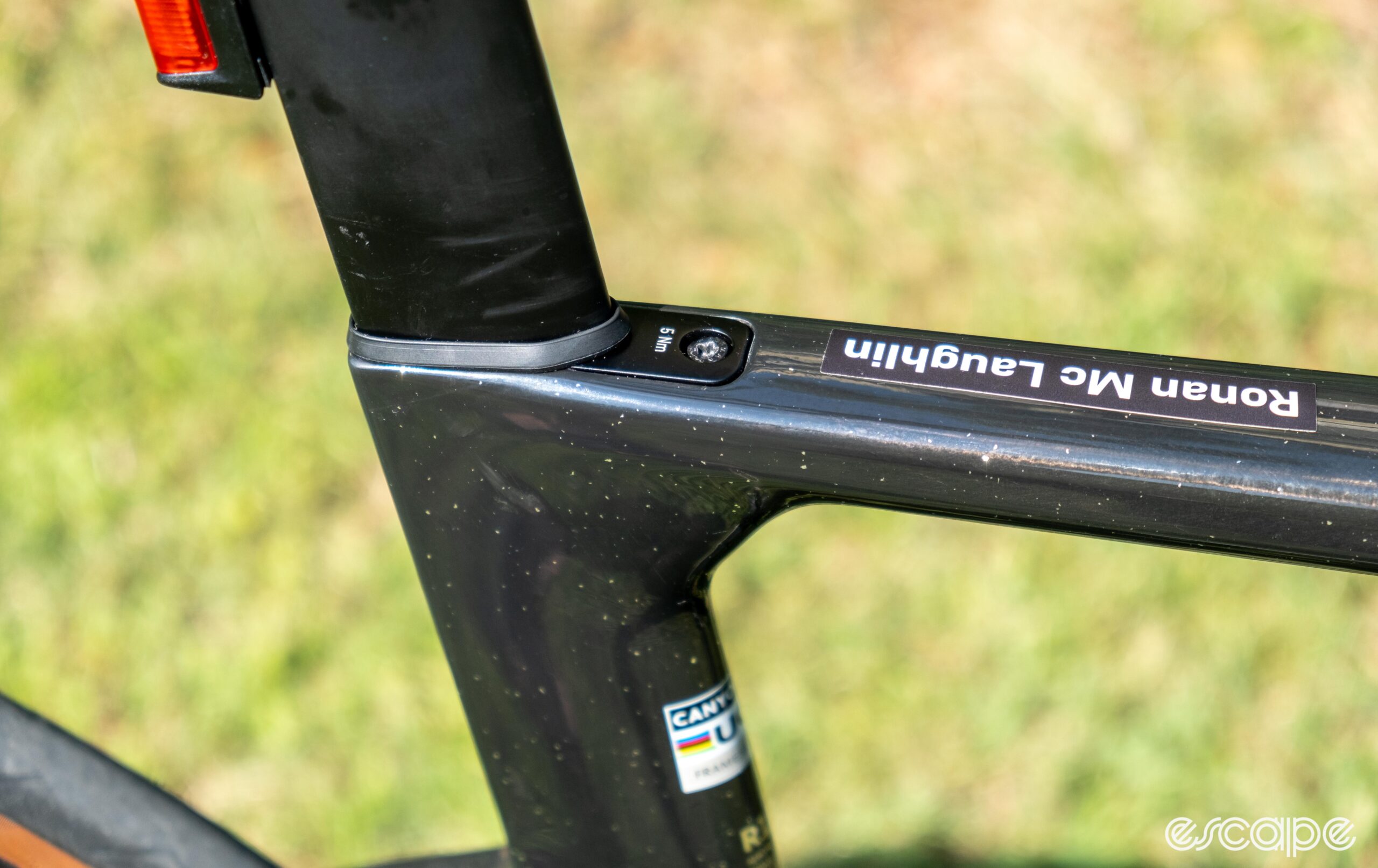
As for what exactly that means for Gen4 ride comfort, Canyon describes it as kind of a halfway house between that original Gen3 concept and the Gen3.5 Aeroad with the same deeper seat tube and seatpost profiles and top tube seatpost clamp that Van der Poel had been riding exclusively for a while. Specifically, Canyon claims the new shallower profiles on the Gen4 allow it to add back some of the ride comfort lost to the new clamp location and that should prove more in line with what the general consumer may desire/require.
The new Aeroad seatpost features a new two-bolt saddle clamp mechanism that looks as good as a single-bolt setup but functions infinitely better. The clamp retains the single side-loaded bolt, which loosening will now only allow the saddle to move fore/aft, while a second bolt on the rear side of the seatpost allows for independent saddle tilt adjustment. It's a style seen previously on the Trek Madone seatpost and others, but Canyon's version is neater and more integrated. Other manufacturers: please take note and do away with the god-awful single-bolt seat clamp once and for all.

As mentioned earlier, the partially external brake hose routing makes the removable drop section possible, but from there, the hoses enter the T-bar/stem section and route through the headset bearings. So, while a drop shape change is quick and easy, the much more common headset bearing change will still require a complete re-bleed of the brake system.
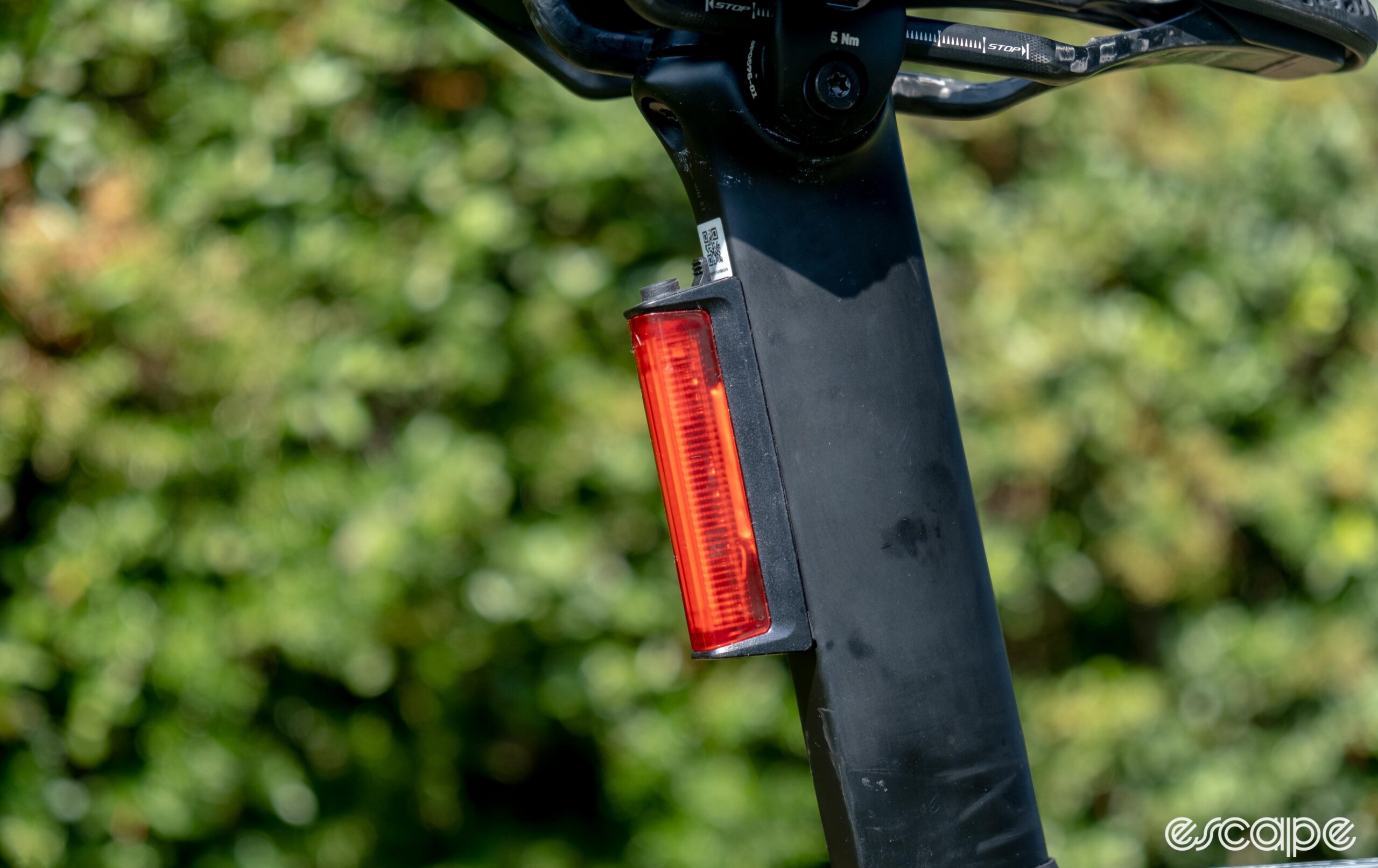

While not disputing that, Canyon has added a host of updates to the headset and associated components as part of the durability and user-friendly push with the new Aeroad. These updates include a titanium crown race said to offer better abrasion resistance, double-lipped seals on the lower bearings, and a larger, better-fitting seal on the upper bearing. Furthermore, Canyon says the bearings themselves are higher quality, and more durable, with hybrid ceramic bearings in the CFR models and stainless steel bearings in the SLX builds.
Canyon is so confident in these updates that they told a press camp Escape attended that the new Aeroad is "pressure washer proof" (although we still don't recommend pressure washing as there are other bearings on a bike beside the headset). As for proof, Canyon claims the new system sustained two weeks of 24/7 running on its test rig, exposing the bearings to a constant blast of dirt, water, and vibrations before they shut the test down because the new setup wasn't yet showing any signs of wear. In comparison, Canyon claims a standard headset (like what was used previously) will show significant signs of wear in just a couple of days. We'll reserve judgment until the Aeroad has spent a week trudging up and down slurry-covered lanes in Ireland.
Fully built to ride, the new Aeroad CFR (M) we have in for review weighs 7.2 kg (15.87 lb). That includes SRAM's new Red AXS groupset, powermeter, Zipp 454 NSW wheels, the PACE bar head unit mount, two bottle cages, and Wahoo Speedplay Zero pedals.
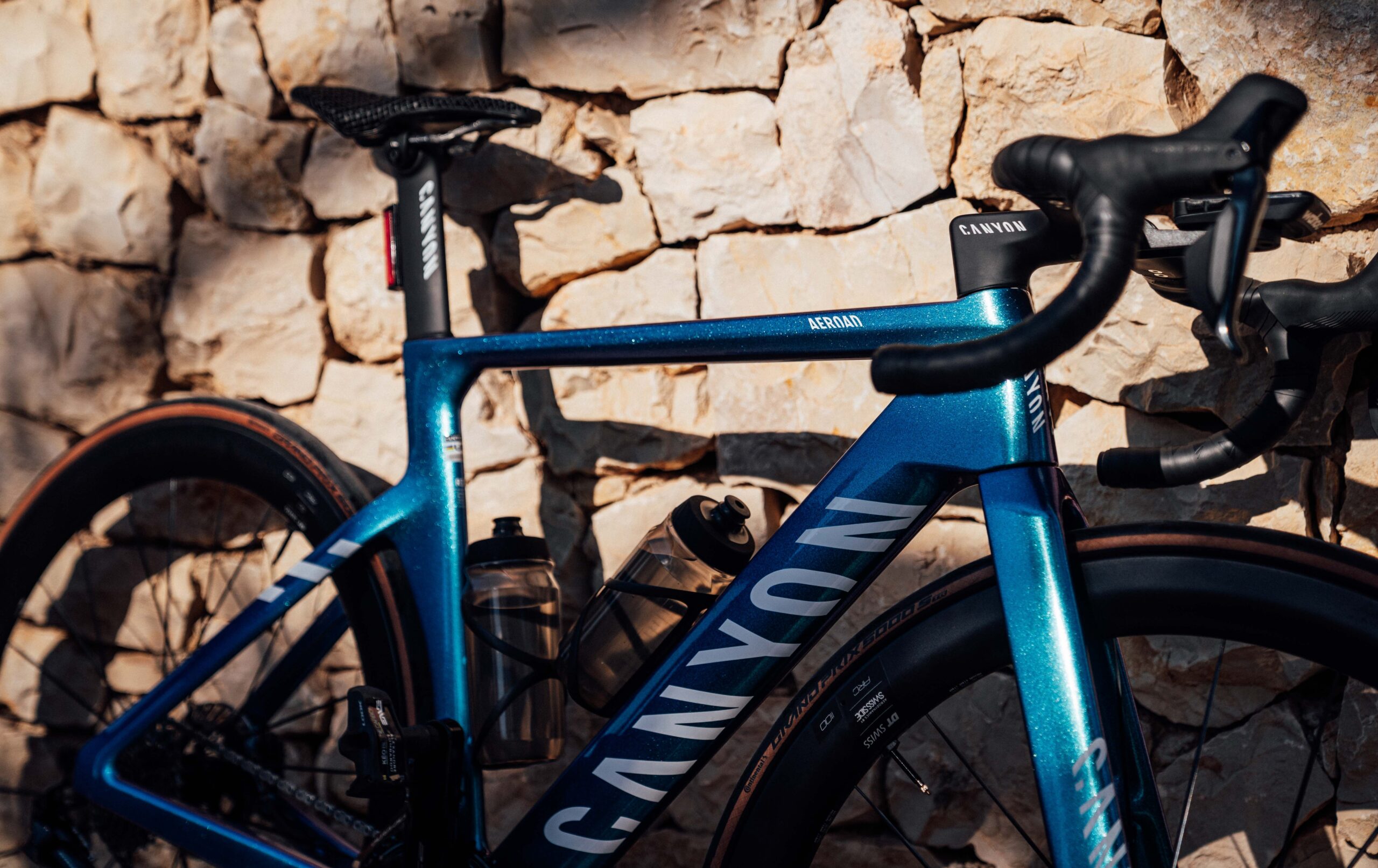
Which gets back to where we started. When images of the new Aeroad first surfaced at the Critérium du Dauphiné in early June, we all assumed it must be lighter given it looks pretty identical. What we now know is that not only does it look almost identical, but it also weighs pretty much the same. In fact, if we consider that the Canyon is now equipping its top Aeroads with shallower, lighter wheels, we can calculate (and confirmed by Canyon) that of the claimed 250 grams (or so) of claimed weight savings, only approximately 50 g was found in the frame, forks, seatpost and handlebars, with the other 200 grams or so coming from the shallower, lighter wheels equipped on the new bike.
Canyon says the aero savings found on the frame module allowed it to used shallower, lighter, and thus better-handling wheels while still achieving a net neutral or even slight positive overall aero package. In other words, Canyon claims the new bike with shallower wheels is as fast as the old one with deeper wheels.
Canyon has done its own aero benchmarking with the new bike against the previous-generation Aeroad, the Cervelo S5, and the Specialized Tarmac SL8, all with DT Swiss ARC1100 50 mm wheels with Schwalbe Pro One TLE 25 front and 28 rear tyres, at 45 km/h in the GST wind tunnel with dummy legs and no bottles. Canyon claims the results show the new bike is an average of 1.6 watts faster across a weighted yaw angle sweep than the previous generation, 2.5 W faster than the S5, and 8 W faster than the SL8.
We do of course have to add a pinch of salt to these numbers, not just because they are Canyon's own testing, but because they also only included dummy legs and not a real rider (there are pros and cons to both), but at least the tests did use standardised wheels and tyres across every bike. What's remarkable is that the Gen3 Aeroad seemingly tested as well as it did, within 1.6 W of the new Aeroad and outperforming newer models and, in the S5, a newer dedicated aero bike.
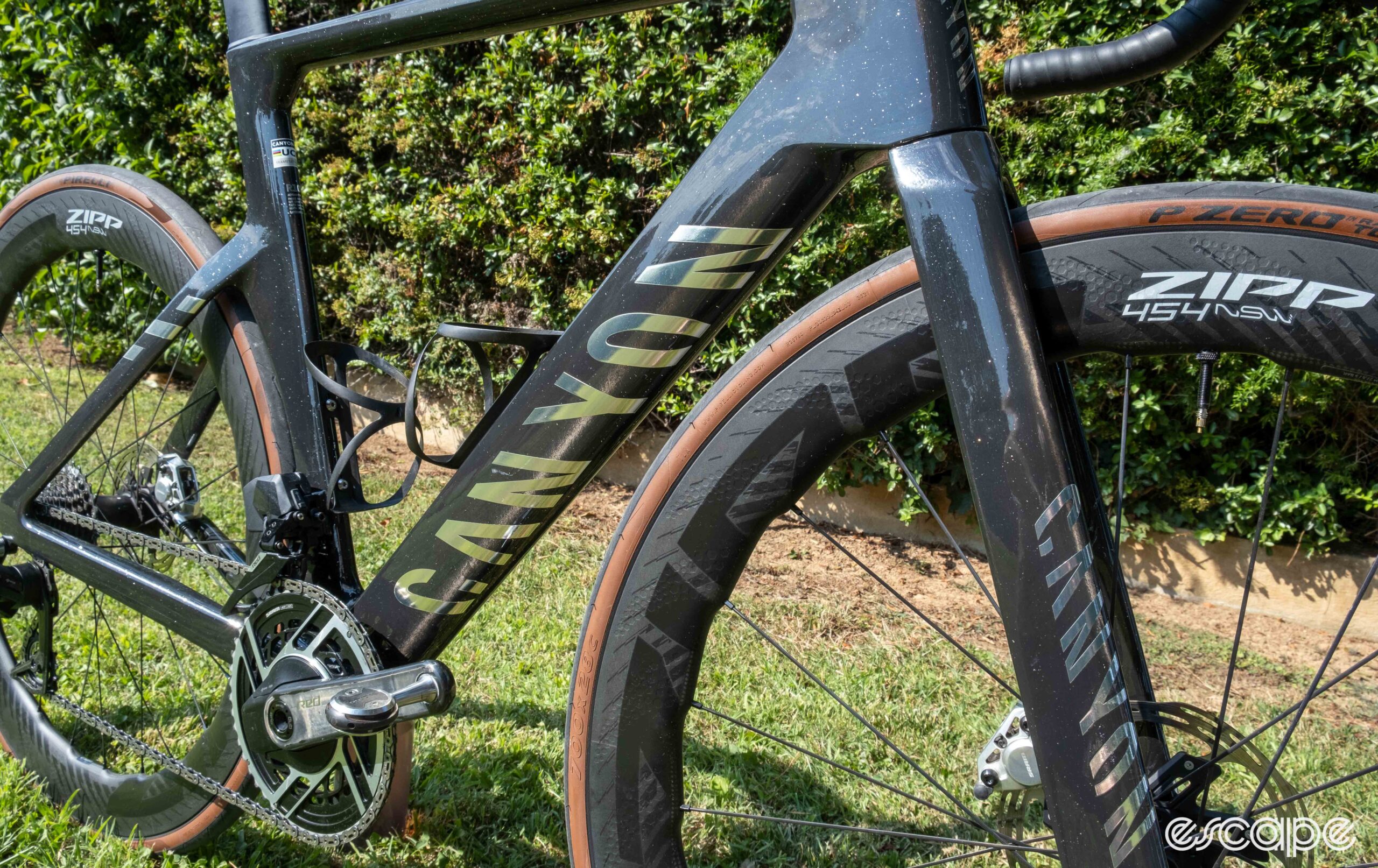
If true, that perhaps suggests there are two winners from the launch of the new Aeroad: future Aeroad owners and existing Aeroad owners. We all know a new version of our pride and joy is only ever a year or two away. For some, that's fine, and for these people, the introduction of a new model makes little to no difference. For others, it's a sad day when a manufacturer supersedes their current bike. Technically, Canyon has done that to the Gen3 today, but the advertised performance gap to a new bike has never been so marginal, nor the aesthetic upgrade so minimal.
There are plenty of tangible usability updates on the new Aeroad. And the same aero performance with lighter more nimble wheels, again if true, is not to be sniffed at. Credit must also go to Canyon if the durability claims prove true; only time will tell on those, but still, it's not often we hear brands tout greater robustness in a new WorldTour-ready race bike, and it's to be applauded when we do. As such, while there's perhaps not enough to tempt an existing Aeroad rider into upgrading, Canyon is certainly presenting an even stronger proposal to the non-Aeroad rider with the Gen4 than it arguably ever has.
The new Aeroad is available in Canyon's range-topping CFR spec with its highest-grade carbon and top-spec builds including a SRAM Red AXS with Zipp 454 NSW wheels (€10,500) build and Dura-Ace Di2 with DT Swiss ARC 1100 Dicut 50 wheelset (€10,000).
Then there are the CF SLX builds, which are more affordable but also heavier thanks to a different carbon layup and: SRAM Rival AXS and a DT Swiss ARC 1600 Spline wheelset (€4,200); or Force AXS with Zipp 404 Firecrest builds (€7000); or Shimano Ultegra Di2 with DT Swiss ARC 1400 Dicut (€6,500); or 105 Di2 with DT Swiss ARC 1600 Spline wheels (€4,800). All builds are equipped as standard with a power meter except the CF SLX 7 Rival AXS bike.
Escape Collective attended the Canyon press launch for the new bike almost seven weeks ago, back at the beginning of June. A longer period of test riding the new bike at home was due to follow, but unfortunately, the review bike only arrived as we headed off to France for Le Tour and Eurobike. As such, a longer-term, deeper-dive review will follow when we've had a chance to get a feel for the new Aeroad on the roads we know best and with more familiar wheels, tyres, and saddle.




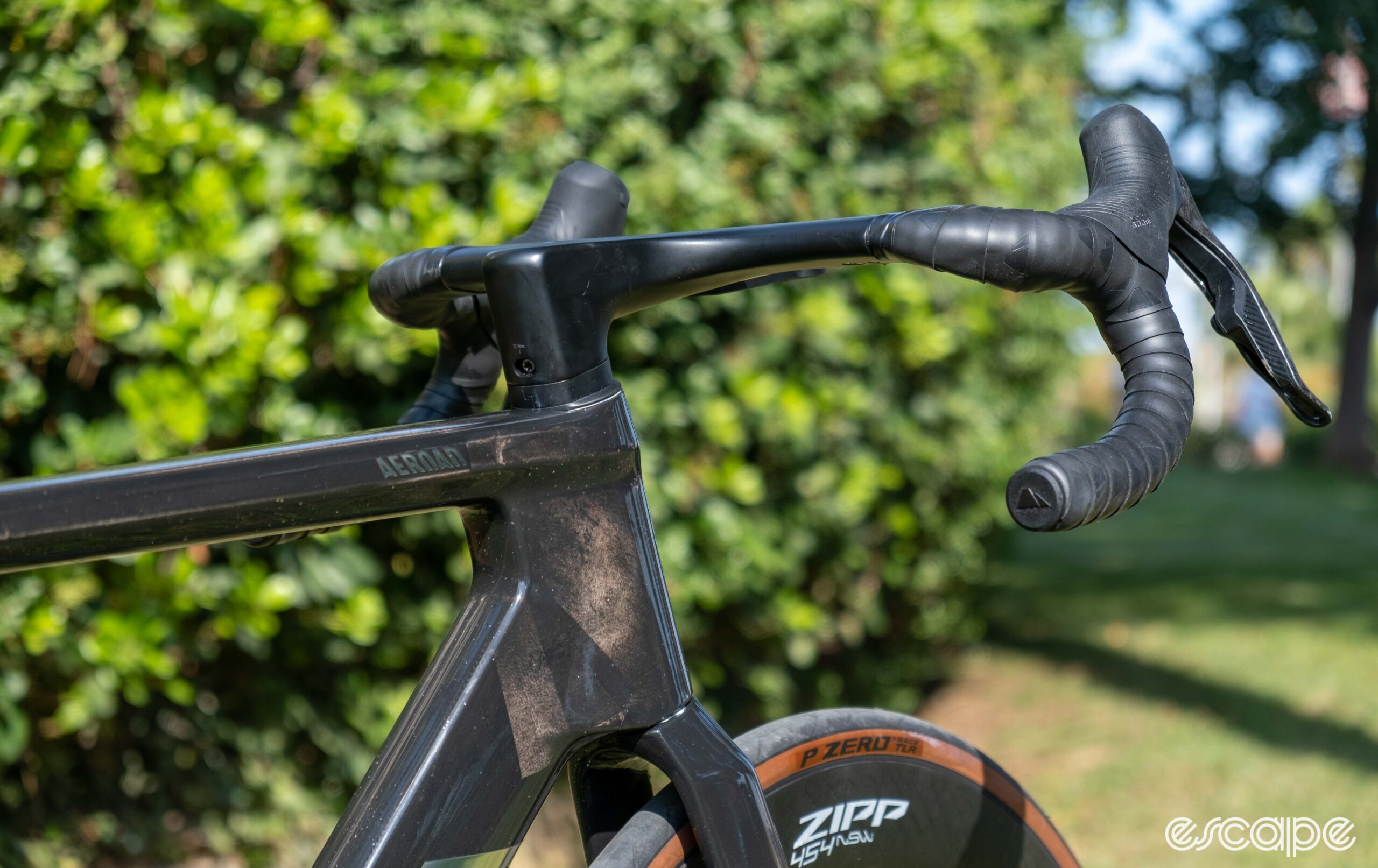
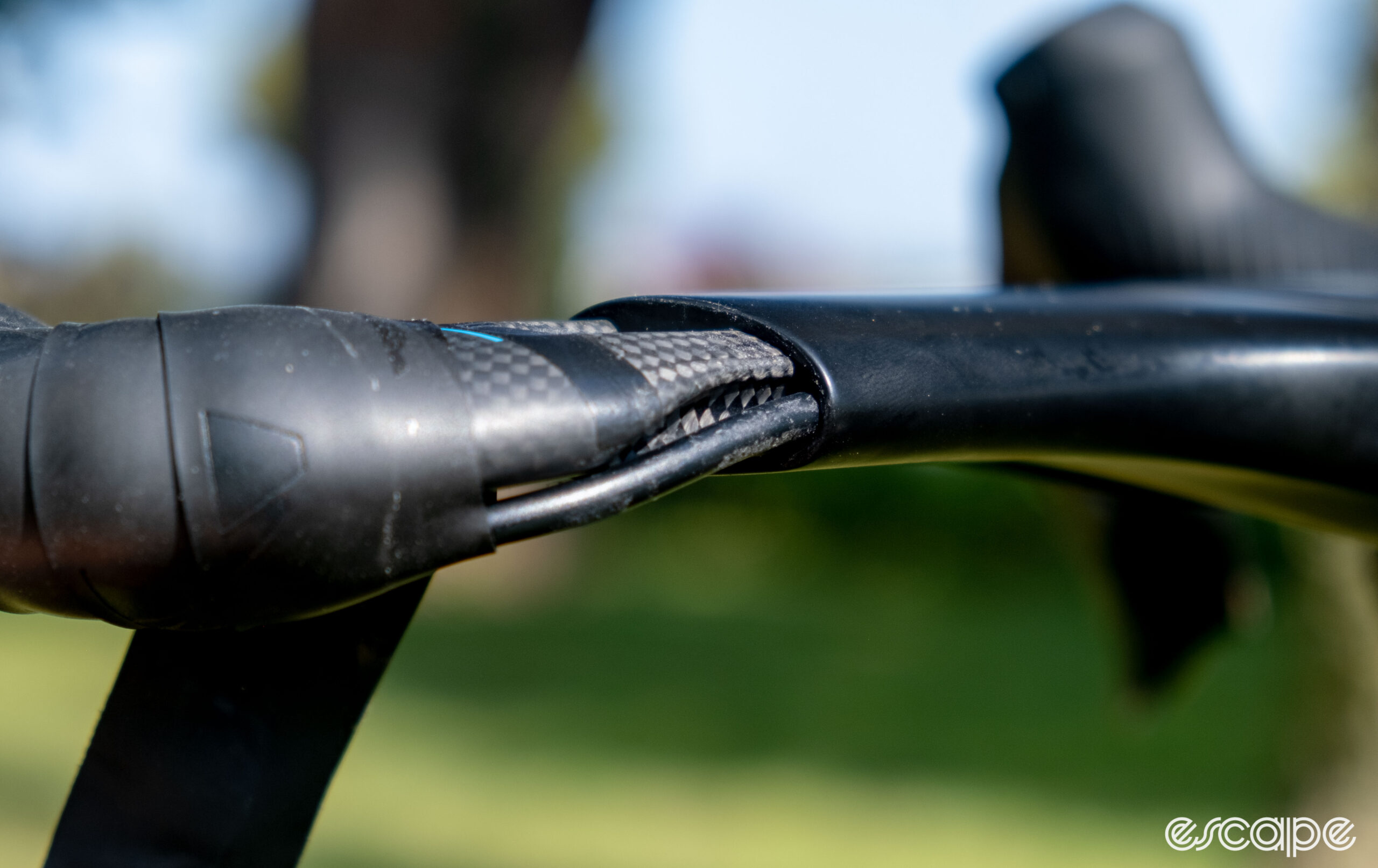


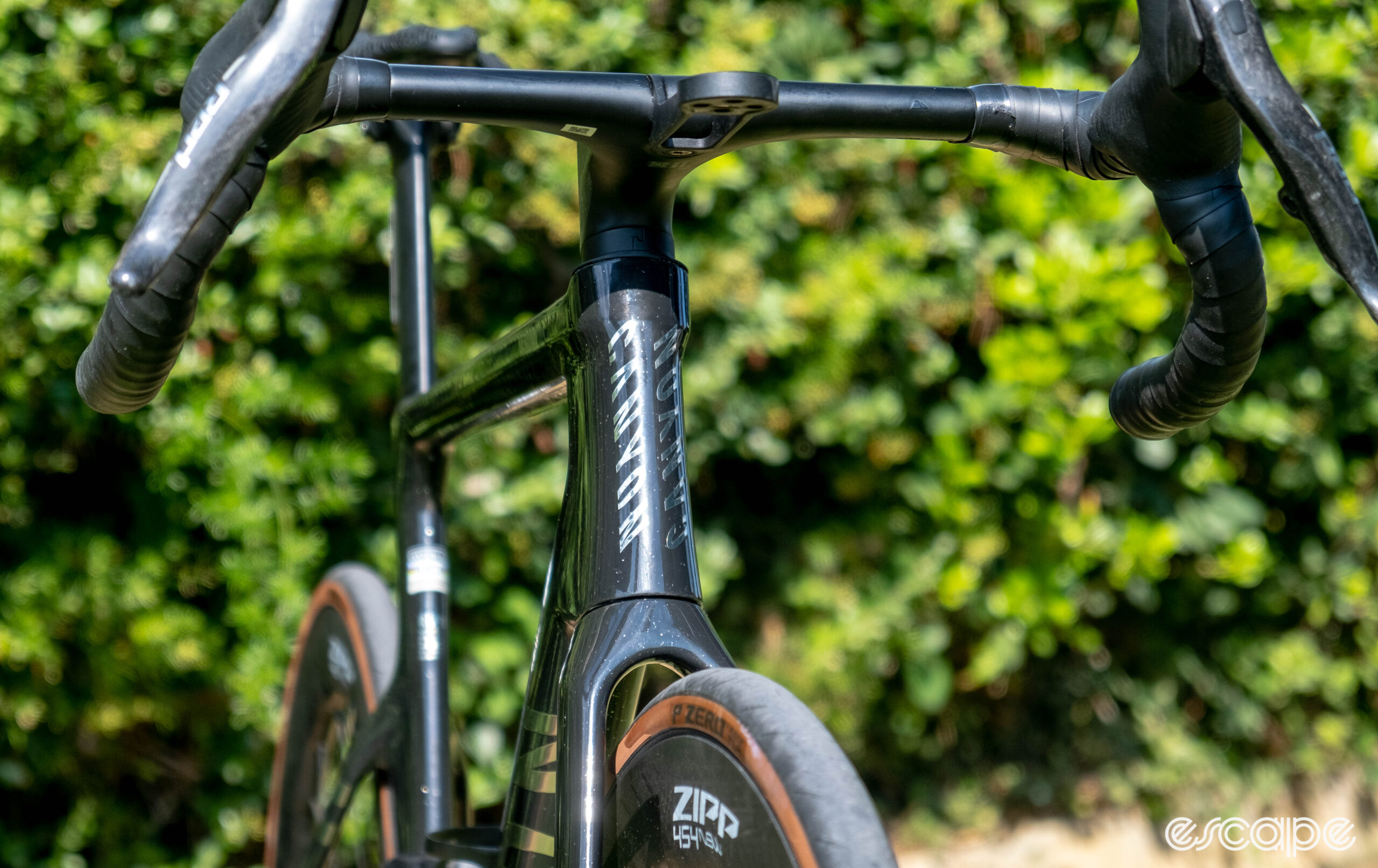


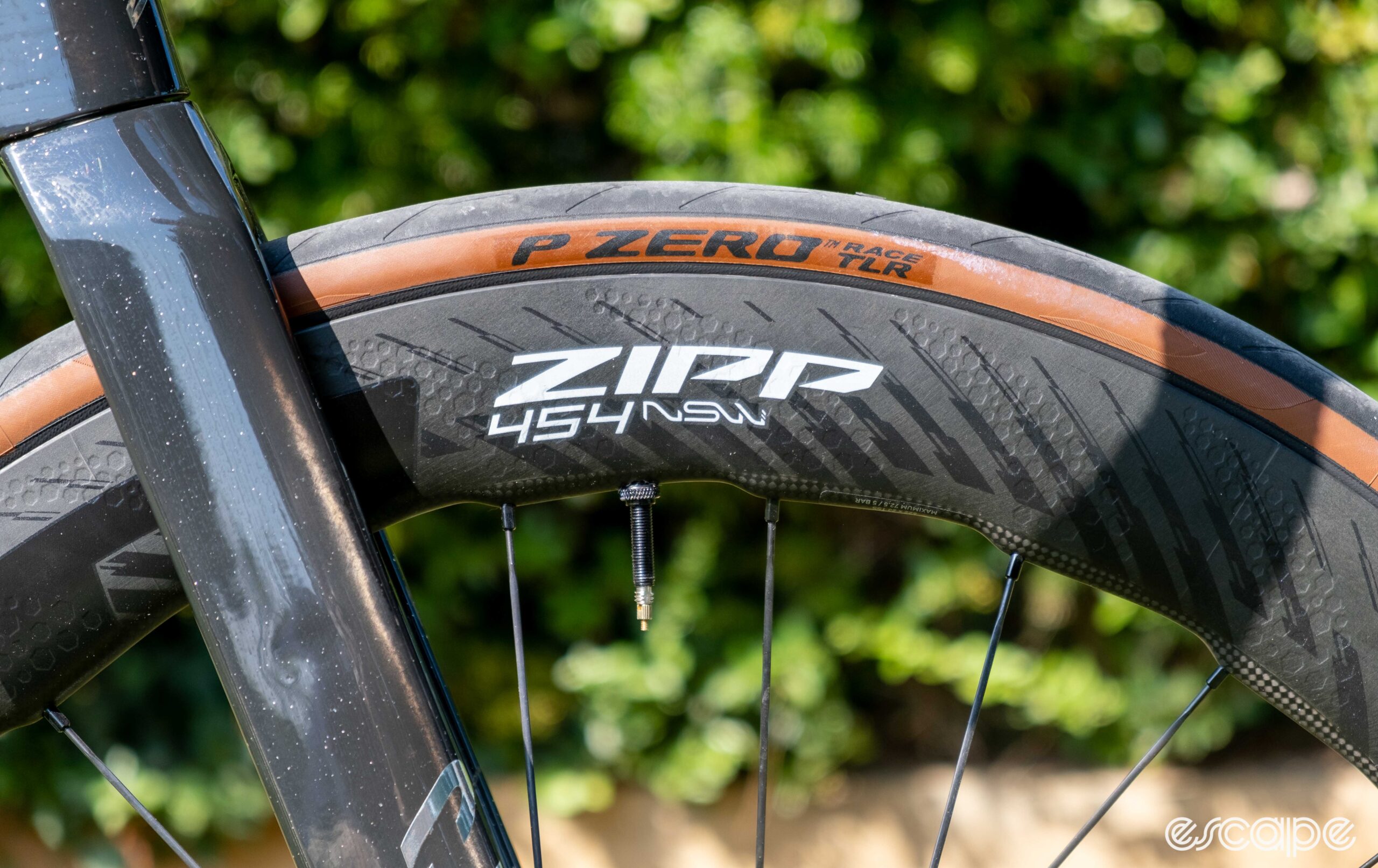
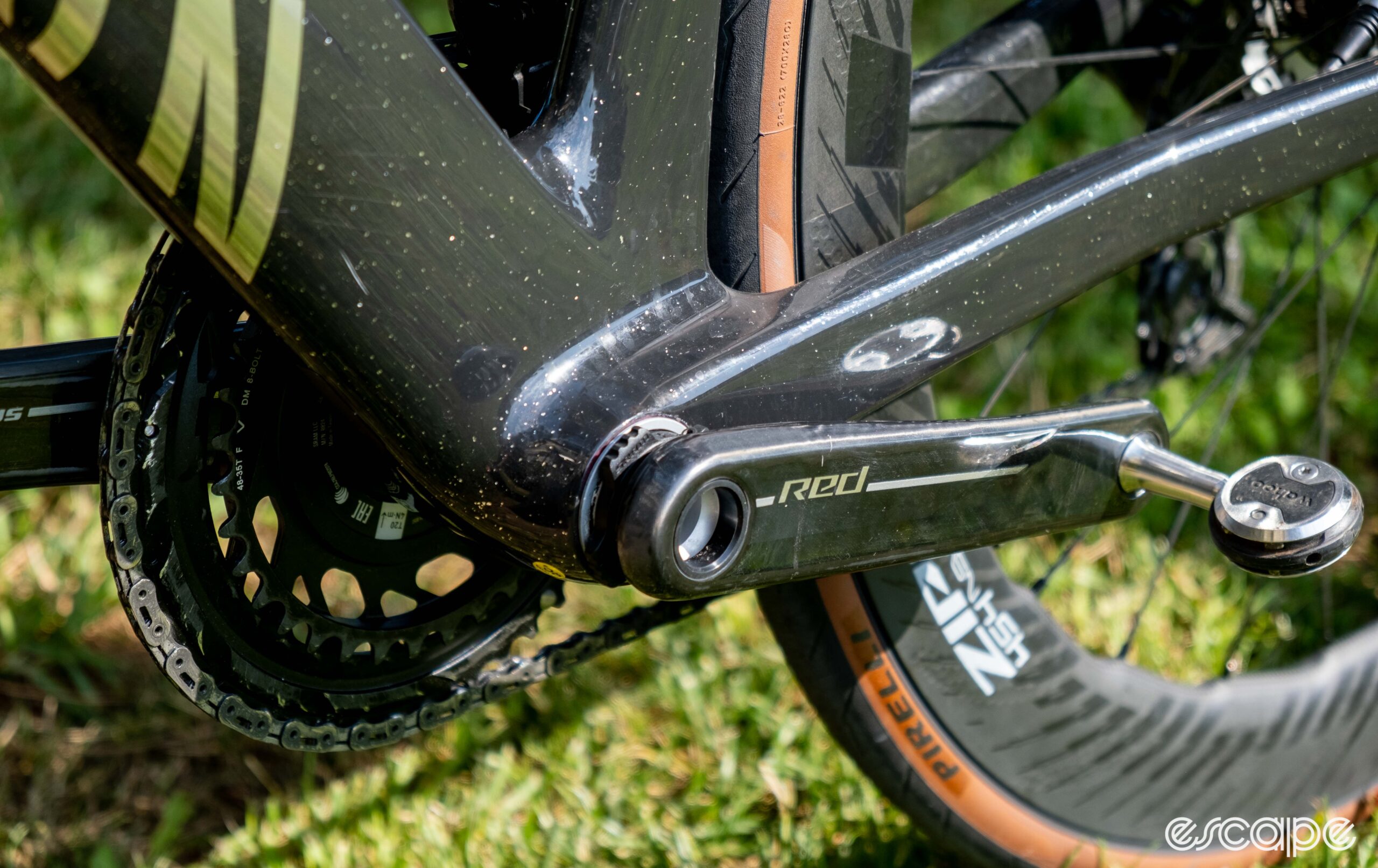
Did we do a good job with this story?




